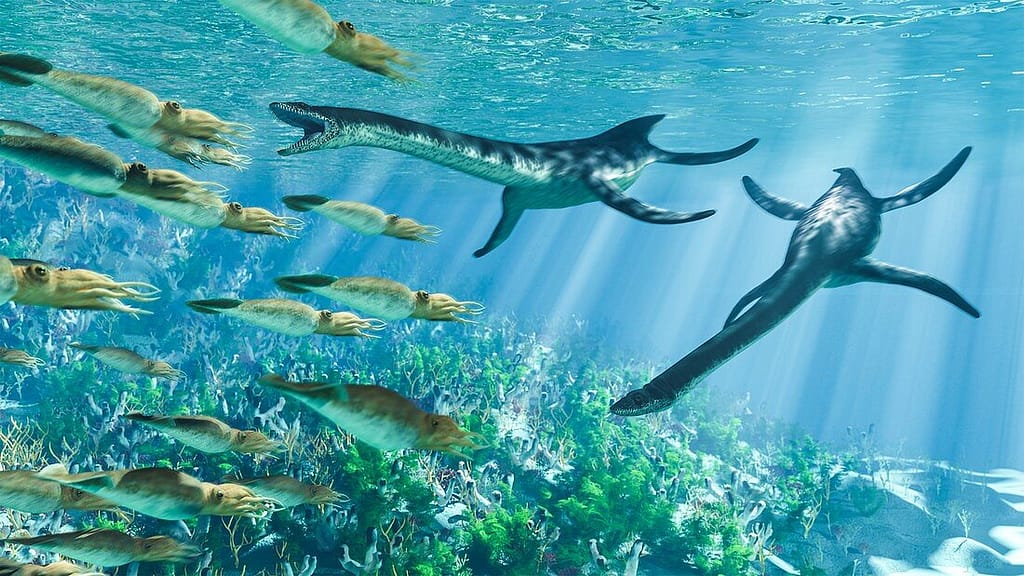
Fascinating Discovery: Plesiosaurs Adapted to Freshwater Environments
In a remarkable find, fossils of small plesiosaurs, the iconic long-necked marine reptiles from the dinosaur era, have been unearthed in the Sahara Desert, once a flourishing river system, dating back 100 million years. This groundbreaking discovery challenges the conventional belief that plesiosaurs were exclusively inhabitants of the sea, as it suggests the possibility of some species thriving in freshwater habitats.
The Enigmatic Plesiosaurs
Originally identified in 1823 by renowned fossil hunter Mary Anning, plesiosaurs were ancient reptiles characterized by their small heads, elongated necks, and four distinctive flippers. These awe-inspiring creatures often served as the basis for depictions of the Loch Ness Monster. However, unlike the mythical creature of Loch Ness, plesiosaurs were primarily regarded as marine animals—until now.
Freshwater Plesiosaurs in Africa
A team of scientists hailing from the University of Bath, the University of Portsmouth, and the Université Hassan II has recently reported the discovery of small plesiosaurs in an African river system from the Cretaceous period. The fossils, including bones and teeth, shed light on the presence of three-meter-long adult plesiosaurs and even a one-and-a-half-meter-long juvenile. These findings indicate that these creatures not only inhabited freshwater environments but also coexisted with frogs, crocodiles, turtles, fish, and the colossal aquatic dinosaur known as Spinosaurus.
Adaptation to Freshwater Life
The presence of plesiosaur fossils in a river system suggests that these creatures had adapted to tolerate freshwater conditions, potentially spending their entire lives in such habitats, much like modern river dolphins. Interestingly, the fossils exhibit similarities to the wear patterns observed in the teeth of Spinosaurus, a fish-eating dinosaur found in the same geological layers. This suggests that plesiosaurs fed on similar prey, likely armored fish that inhabited the river, implying their prolonged stay in freshwater rather than occasional visits.
Plesiosaurs: A River-Dwelling Hypothesis
While it is known that certain marine animals such as whales and dolphins occasionally venture into rivers for feeding or due to disorientation, the abundance of plesiosaur fossils in the river system suggests a different scenario. It is plausible that these plesiosaurs possessed the ability to adapt to both fresh and saltwater environments, similar to certain whale species like the beluga whale. Moreover, their small size would have made them well-suited for hunting in shallow rivers, and the rich variety of fish found in the fossils further supports this notion.
Paleontological Controversies and Speculations
Dr. Nick Longrich, the corresponding author of the research, acknowledges the controversy surrounding the presence of plesiosaurs in freshwater habitats. He points out that the classification of plesiosaurs as "marine reptiles" does not necessarily restrict their living environments to the sea, as many marine lineages have successfully colonized freshwater ecosystems throughout evolutionary history. He draws parallels with the evolutionary occurrences of freshwater dolphins in various rivers globally and even mentions the presence of freshwater seals in Lake Baikal. The adaptability and diversity of plesiosaurs, spanning over 100 million years, suggest the possibility of repeated invasions of freshwater habitats to varying extents.
Unraveling Ancient Ecosystems
Studying isolated bones and teeth provides valuable insights into ancient ecosystems and the animals that inhabited them. Although the fossils discovered in Morocco's Sahara Desert are scattered and found in different locations, each bone and tooth represents a distinct individual, resulting in a collection of over a dozen plesiosaurs. While the bones indicate where the animals perished, the teeth offer intriguing clues about their preferred habitats, as they were shed during the creatures' lifetimes.
The Quest for Answers
The scientific community readily acknowledges that understanding the lives of extinct animals from millions of years ago is a challenging task. Paleontologists can only make educated speculations based on the available information, and further discoveries may either confirm or debunk these hypotheses. Lead author Georgina Bunker highlights the evolution of the project, which began with a single bone as an undergraduate endeavor and gradually unfolded to reveal a clearer picture of these captivating creatures.
A Window into Ancient Morocco
This new finding expands the understanding of Morocco's Cretaceous period and the remarkable diversity that once thrived there. Dr. Samir Zouhri expresses excitement over this sensational discovery, which joins the growing list of remarkable finds in the Kem Kem region of Morocco. Known as a biodiversity hotspot during the Cretaceous period, the Kem Kem region continues to astonish scientists with its fossil treasures.
A Fascinating Chapter in Plesiosaur History
The coexistence of numerous carnivorous species in the ancient Moroccan river is truly remarkable. However, for those wondering about the implications for the Loch Ness Monster legend, the possibility of plesiosaurs inhabiting freshwater environments provides some plausibility. Nonetheless, according to the fossil record, the last plesiosaurs disappeared around 66 million years ago, coinciding with the extinction of the dinosaurs, leaving behind a captivating chapter in Earth's history.




